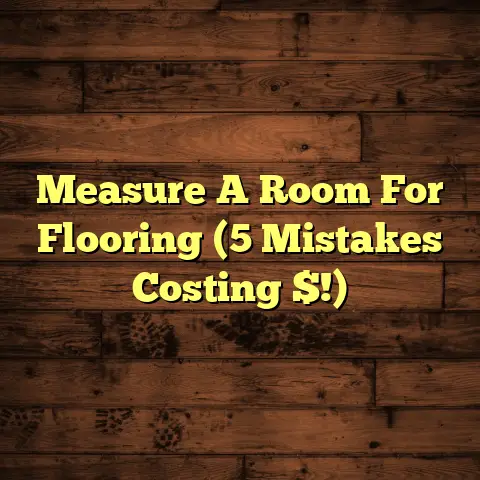Stick-On Wood Tile? (Top 3 Looks REVEALED!)
Ever walk into a room and feel like something’s just… off?
More often than not, it’s the flooring.
I’ve seen it time and again in my years as a flooring contractor:
People underestimate the massive impact flooring has on a space.
They pick something cheap, something quick, and then they’re stuck with a room that just doesn’t feel right.
It’s a costly mistake, believe me.
Replacing flooring is a pain, and it hits the wallet hard.
But what if I told you there’s a budget-friendly, surprisingly stylish solution that could transform your room?
Enter: stick-on wood tiles.
Now, I know what you might be thinking: “Stick-on? Really?”
Trust me, these aren’t your grandma’s peel-and-stick tiles.
With the right design choices, stick-on wood tiles can create stunning looks that rival real hardwood, without breaking the bank.
And today, I’m going to reveal my top 3 favorite looks!
1. Understanding Stick-On Wood Tiles
So, what exactly are stick-on wood tiles?
Let’s get this straight.
They’re not the same as traditional hardwood, nor are they your standard vinyl roll.
Stick-on wood tiles, also known as peel-and-stick wood planks, are typically made from a few different materials.
Most often, you’ll find them constructed from:
-
Vinyl: This is the most common material, offering water resistance and durability.
-
Composite: Some higher-end options use a composite core for added stability and a more realistic feel.
-
Adhesive Backing: This is the magic ingredient, allowing for easy installation.
The manufacturing process usually involves printing a high-resolution image of wood grain onto the vinyl or composite layer, then adding a protective wear layer and the adhesive backing.
Now, let’s talk advantages.
Why should you even consider stick-on wood tiles?
Here’s the breakdown from my experience:
-
Cost-Effectiveness: This is the big one. Stick-on tiles are significantly cheaper than hardwood, engineered wood, or even some laminate options. I’ve seen projects where people saved 50-70% by going with stick-on tiles.
-
Ease of Installation: This is a DIYer’s dream. No special tools, no messy adhesives, no complicated techniques. Just peel and stick. I’ve taught complete beginners to install these in a weekend.
-
Versatility: Stick-on tiles come in a huge range of colors, styles, and sizes. You can mimic almost any type of wood, from rustic oak to sleek ebony.
Now, let’s tackle those misconceptions.
I often hear people say things like:
“Stick-on tiles look cheap.” or “They’re not durable.”
And honestly, some of them do.
But the quality has improved dramatically in recent years.
With proper prep and installation, and by choosing a decent brand, stick-on tiles can be surprisingly durable and aesthetically pleasing.
I’ve seen installations that have lasted for years with minimal wear and tear.
The key is to do your research, choose quality products, and follow the installation instructions carefully.
2. The Top 3 Looks for Stick-On Wood Tiles
Alright, let’s get to the good stuff!
I’m going to walk you through my top 3 favorite looks you can achieve with stick-on wood tiles.
And I will share some tips and tricks I’ve picked up over the years.
2.1 Rustic Charm
Ah, the rustic look.
It’s all about warmth, texture, and that cozy, lived-in feel.
Think crackling fireplaces, comfy blankets, and the smell of pine.
When it comes to flooring, rustic charm means embracing natural imperfections and celebrating the beauty of aged wood.
For color palettes, you’ll want to stick with warm, earthy tones.
Think:
-
Honey browns: These evoke a sense of warmth and comfort.
-
Sandy beiges: They provide a neutral backdrop that complements other rustic elements.
-
Deep reds: These add a touch of richness and sophistication.
-
Gray-browns (Greige): These offer a modern twist on rustic, blending the warmth of brown with the coolness of gray.
As for styles, reclaimed wood is the holy grail of rustic flooring.
But let’s be real, authentic reclaimed wood is expensive and difficult to work with.
That’s where stick-on wood tiles come in.
You can find tiles that perfectly mimic the look of reclaimed wood, complete with knots, grain variations, and even simulated saw marks.
I’ve used these to create stunning rustic floors that look incredibly authentic.
Here’s a tip: look for tiles with embossed textures.
This adds another layer of realism and makes the flooring feel more like real wood.
Now, how do you pair this look with furniture and decor?
Here’s my advice:
-
Embrace natural materials: Think wood, leather, stone, and cotton. These will complement the rustic flooring and enhance the overall aesthetic.
-
Add texture: Use textured rugs, woven baskets, and chunky knit blankets to create a cozy and inviting space.
-
Don’t be afraid of imperfections: Rustic charm is all about celebrating the beauty of the imperfect. Embrace distressed furniture, vintage finds, and handmade items.
-
Incorporate greenery: Plants add life and freshness to any space, but they’re especially effective in a rustic setting. Consider adding potted herbs, succulents, or even a small tree.
I remember one project where I used stick-on reclaimed wood tiles in a client’s sunroom.
We paired it with a comfy leather armchair, a woven rug, and a few potted plants.
The result was a warm, inviting space that felt like a cozy cabin retreat.
2.2 Modern Minimalism
Let’s shift gears and talk about modern minimalism.
This look is all about clean lines, neutral colors, and simplicity.
Think uncluttered spaces, functional furniture, and a sense of calm.
In the world of flooring, modern minimalism translates to sleek, unassuming surfaces that complement the overall aesthetic without drawing too much attention.
When choosing stick-on wood tiles for a modern minimalist look, you’ll want to focus on light, neutral colors.
Here are some great options:
-
Light oak: This is a classic choice that adds warmth and sophistication without being too overwhelming.
-
White-washed finishes: These create a bright, airy feel that’s perfect for small spaces.
-
Light gray: This is a cool, contemporary option that pairs well with other neutral colors.
-
Beige: This is a versatile choice that can be used to create a warm or cool minimalist look, depending on the undertones.
Avoid anything too dark, too busy, or too textured.
You want the flooring to blend seamlessly into the background.
Specific stick-on wood tile designs that align with this aesthetic include:
-
Wide planks: These create a sense of spaciousness and flow.
-
Matte finishes: These are less reflective than glossy finishes, which helps to create a more subtle and understated look.
-
Minimal grain patterns: Avoid tiles with overly dramatic grain patterns. Instead, opt for something with a more subtle and consistent texture.
Maintaining a clutter-free environment is crucial for achieving the modern minimalist look.
Here’s how flooring plays a role:
-
Creates a sense of spaciousness: Light-colored flooring can make a small room feel larger and more open.
-
Provides a neutral backdrop: Simple, unassuming flooring allows other design elements to shine.
-
Promotes a sense of calm: A clean, uncluttered floor can help to create a more peaceful and relaxing environment.
To incorporate modern minimalist design principles into your home’s overall decor, consider these tips:
-
Focus on function: Choose furniture and accessories that are both stylish and functional.
-
Embrace negative space: Don’t be afraid to leave some areas of your room empty. This will help to create a sense of balance and harmony.
-
Use a limited color palette: Stick to a few key colors and use them consistently throughout the space.
-
Invest in quality: Choose high-quality materials and craftsmanship that will last for years to come.
I once helped a client transform her small apartment into a modern minimalist oasis using light oak stick-on wood tiles.
We paired it with simple white furniture, a few carefully chosen accessories, and plenty of natural light.
The result was a clean, airy space that felt both stylish and inviting.
2.3 Sleek Chic
Finally, let’s talk about the sleek chic look.
This style blends contemporary design with a touch of elegance and sophistication.
Think modern furniture, bold accents, and a sense of polished glamour.
When it comes to flooring, sleek chic means embracing darker wood tones, glossy finishes, and geometric patterns.
These elements can add drama and sophistication to any space.
For stick-on wood tiles, consider these design elements:
-
Darker wood tones: Think espresso, walnut, or even black. These colors create a sense of richness and luxury.
-
Glossy finishes: These reflect light and add a touch of glamour to the flooring.
-
Geometric patterns: Herringbone, chevron, or even simple stripes can add visual interest and sophistication.
-
Wider planks: These create a sense of spaciousness and flow, especially in larger rooms.
Stick-on wood tiles can contribute to creating a sophisticated atmosphere in spaces like living rooms and dining areas.
Here’s how:
-
Adds drama and depth: Darker wood tones can make a room feel more intimate and inviting.
-
Creates a focal point: Geometric patterns can draw the eye and add visual interest to the flooring.
-
Enhances the overall aesthetic: Sleek, chic flooring can elevate the entire look of a room.
To complement this style effectively, pay attention to accessorizing and lighting.
Here’s my advice:
-
Use metallic accents: Gold, silver, or brass can add a touch of glamour to the space.
-
Incorporate bold colors: Use pops of color in your accessories to add visual interest and personality.
-
Choose statement lighting: A chandelier, pendant light, or even a well-placed floor lamp can add drama and sophistication.
-
Don’t be afraid to mix textures: Combine smooth surfaces with rough textures to create a sense of depth and complexity.
I recently helped a client transform her dining room into a sleek chic showstopper using dark walnut stick-on wood tiles in a herringbone pattern.
We paired it with a modern glass dining table, velvet chairs, and a stunning chandelier.
The result was a sophisticated and glamorous space that was perfect for entertaining.
3. Installation and Maintenance Tips
Okay, you’ve got your look in mind.
Now, let’s talk about installation and maintenance.
The beauty of stick-on wood tiles is their DIY-friendliness.
Here’s a brief overview of the installation process:
-
Prepare the Surface: This is crucial. The floor needs to be clean, dry, and level. I usually recommend using a floor leveler if there are any uneven spots.
-
Plan Your Layout: Decide how you want the tiles to be arranged. Consider the direction of the planks and any patterns you want to create.
-
Peel and Stick: Remove the backing from the tile and carefully position it on the floor. Press firmly to ensure a good bond.
-
Cut as Needed: Use a utility knife to cut tiles to fit around walls, corners, and other obstacles.
-
Roll It Out: After installation, use a floor roller to ensure that all the tiles are securely adhered to the subfloor.
For maintenance, here are a few tips to keep your stick-on wood tiles looking their best:
-
Regular Cleaning: Sweep or vacuum regularly to remove dirt and debris. Mop with a damp cloth and a mild detergent.
-
Avoid Harsh Chemicals: Don’t use abrasive cleaners or solvents, as these can damage the surface of the tiles.
-
Protect from Scratches: Use furniture pads under heavy objects to prevent scratches and dents.
-
Clean Spills Immediately: Wipe up spills as soon as possible to prevent staining.
Here are some common pitfalls to avoid during installation and care:
-
Not Preparing the Surface Properly: This is the biggest mistake people make. If the surface isn’t clean, dry, and level, the tiles won’t adhere properly.
-
Using Cheap Tiles: Not all stick-on tiles are created equal. Invest in a decent brand to ensure durability and longevity.
-
Ignoring the Manufacturer’s Instructions: Always read and follow the manufacturer’s instructions carefully.
-
Over-Wetting the Floor: When mopping, use a damp cloth, not a soaking wet one. Excess water can seep under the tiles and damage the adhesive.
Conclusion
So, there you have it!
My top 3 looks you can achieve with stick-on wood tiles.
From rustic charm to modern minimalism to sleek chic, these versatile tiles can transform any room without breaking the bank.
Remember, choosing the right design is crucial.
Don’t make the common mistake of underestimating the impact of flooring.
Take the time to research your options, consider your personal style, and choose tiles that will complement your overall aesthetic.
I encourage you to explore the three styles I’ve discussed today and consider stick-on wood tiles as a viable flooring option for your home.
With a little creativity and effort, you can create a stunning space that you’ll love for years to come.
And who knows, maybe you’ll even impress your friends and neighbors with your budget-friendly flooring makeover!




